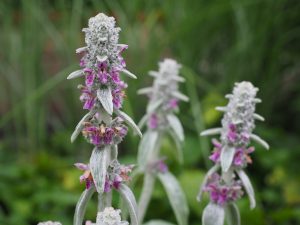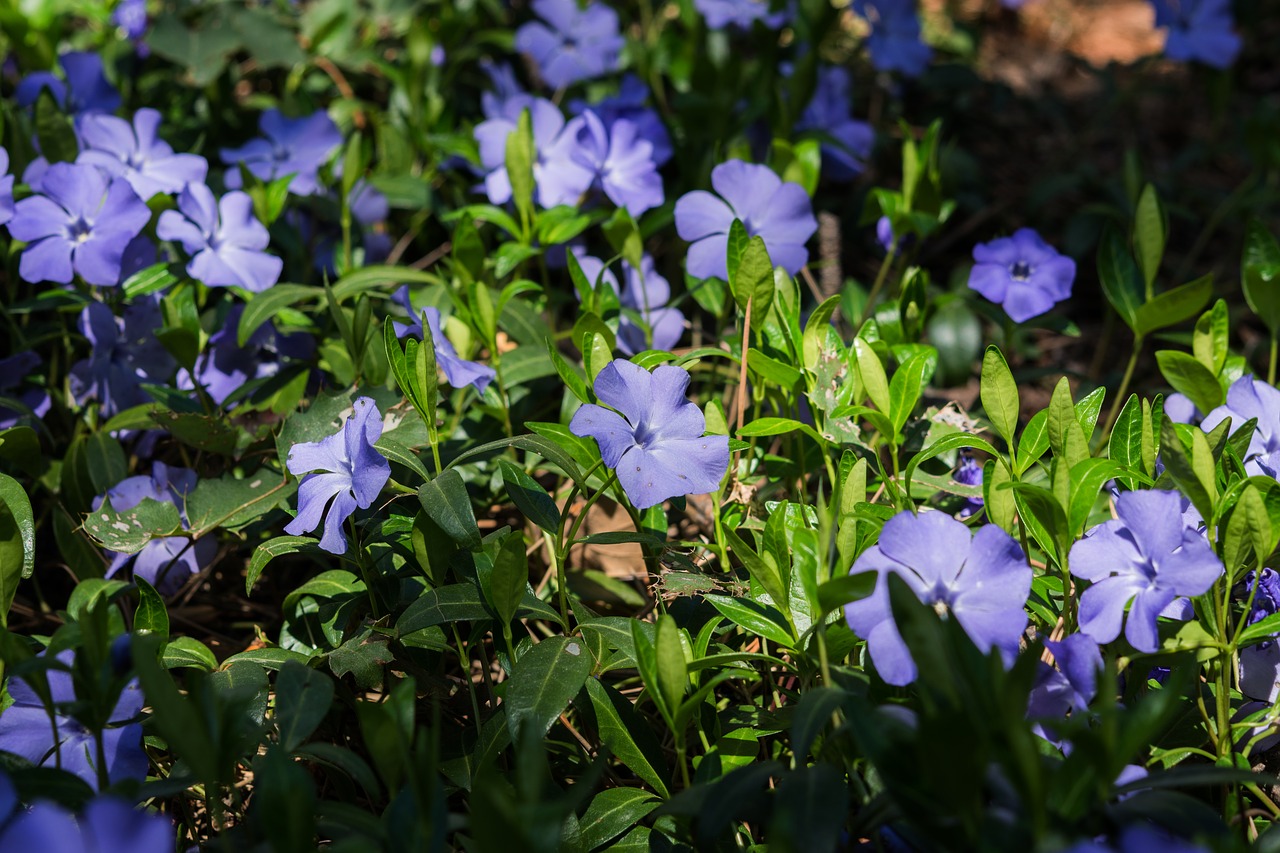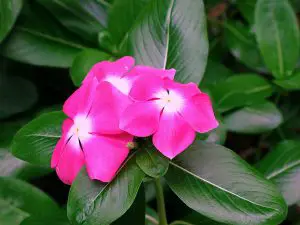Last Updated on April 10, 2024 by Real Men Sow
It can be amazing to collect beautiful specimen plants, flowers with rich colours, but large gardens often have many spaces where ground cover can fill in those gaps. This helps suppress weeds and retains moisture better. Evergreen ground cover plants are available in many varieties that can fill in any garden’s gaps, regardless of the soil or climate.
Top 10 Evergreen Ground Cover Plants in The UK
Vinca Minor (periwinkle)
This is the best ground cover for those who need tough, low-maintenance options. This ground cover shrub is well-known for its creeping gross nature and ability to quickly take over an area. It’s a great choice for anyone looking for a matt-forming ground cover shrub like Pachysandra.
It is also known as the creeping Myrtle or the common Periwinkle. At maturity, it will be no taller than 15cm and can grow up to 45cm in length. It can be grown in full or partial shade, so it is very adaptable.
It is tolerant to all soil types, including clay soil, normal soil and sandy soil. Proper drainage is the only requirement for soil. To get them to fill in a space quickly, you should place them at least 30 cm apart when you plant them. They are quite drought-tolerant once they reach maturity. They can spread quickly and are effective at holding soil in place, which is a crucial component in a sloped garden that has to contend with soil erosion.
The flowers that are produced between May-June are one of the most appealing features of this plant. You can choose from a variety of blue, purple, or even white flowers. Some are rich in shading and others are white near the stamen.
Hebe pinguifolia ‘Pagei’
This evergreen shrub has simple leaves and spikes which produce flowers in the Summer and Autumn. This dwarf evergreen is a low-growing shrub that can be planted in areas with other shrubs.
It can reach up to 30cm high and spreads to form a dense mat measuring 90cm wide. The silvery-blue toned leaves are offset by the spring and summer white flowers.
It can thrive in either full sun or partial shadow and can grow in any soil, including clay, and loam, as long as it is well-drained and moist. The plant can tolerate a variety of neutral and alkaline soils.
Euonymus emerald n gold
The luminous leaves give this plant its name. This evergreen shrub, also known as the wintercreeper, is extremely low-growing and can be used to cover ground. It spreads and creates a thick mat of glossy leaves. The first are dark green with a light golden edging. In the autumn and winter, they become sweetly pink. You might actually see more gold and yellow than green at certain points. This gives it its delightful combination of emerald, gold, and gold. You will see small, greenish flowers at the start of summer.
This plant can be grown on slopes to help control erosion. It can also be used as a trailing groundcover. If properly trained, the same plant can be used as a trailing ground cover and as a climbing plant.
It can tolerate medium to average moisture and will thrive in full sun or shade. The plant can also be incorporated into very moist soils, as it is taller. It can reach 60cm high and 120cm in width.
Pachysandra terminalis (Japanese spurge)
This plant thrives in well-drained, rich soil under partial shade or full sun. However, It will begin to lose its green color if it is exposed to too much sunlight. This is why it is often planted under large trees.
It can be used as groundcover and will eventually spread to large colonies. These colonies will have evergreen leaves in the winter, and showy white flowers in April. Although they aren’t particularly impressive, these tiny white flowers can be found on spikes. They create a beautiful backdrop for your garden.
This plant is very popular for ground cover in shaded areas and is great for planting on slopes or banks, or under trees or along paths, or around shrubs in your garden.
Galium odoratum (Sweet-scented bedstraw)
Galium odoratum, also known as the sweet-scented bedstraw, is a perennial that can tolerate heavy shade, making it an ideal evergreen groundcover for areas with more shade. It will grow to a height of no more than one-quarter meter at maturity and spread no more than one-half meter. This makes it an ideal choice for gardens looking for a low-growing option. However, in most areas of the UK it will grow all year and not die back.
It can grow well in soil that is well-drained and has partial or full shade. The plant slow to grow and uses creeping roots as well as self-seeding for expansion but it will grow quickly if you provide the right conditions for growth but you might need to restrict it depending on where you live. The name comes from the dark, fragrant leaves it produces. While many plants may have fragrant flowers, this plant has both fragrant leaves and flowers. Because of their strong scent, the leaves can be dried and used to make potpourri. You can also make May wine with the leaves.
 Stachys byzantina (Lambs ears)
Stachys byzantina (Lambs ears)
Lamb’s Ear ground cover is colourful and has soft, greyish-green leaves. It is known for its velvety, thick leaves. The leaves can be evergreen in warmer climates and will quickly spread to form a mat of leaves about 15 cm above the ground.
This makes it suitable for low-to-the-ground coverings. It can tolerate rabbits and deer, dust, rocky soil, drought, and even air pollution. It requires very little maintenance once it is planted. They are most vulnerable to leaf spot if there is too much moisture. You need to ensure that you don’t over-water and that the soil drains well.
Although there are some flowers that appear between May-July, they are usually small and purple and considered insignificant by many gardeners. Many gardeners actually remove flowering stems to ensure that the stunning sea of grey-green foliage is not interrupted.
Ajuga reptans (Common bugle)
This plant, also known as the common bugle, is easy to grow in well-drained soil and gets full sun or partial shading exposure.
It can tolerate moderately dry soils, but prefers moist soil. The best conditions for flower production and colour will help increase their quality. The plants can grow in all conditions, but they might not be as bright. If it gets too crowded, the plant will need good air circulation.
It will form a mat-like layer of ground covering that is perfect for suppressing weeds once it has started growing. To rejuvenate the plant, you can trim it to the ground after it has produced the flowers that are a rich blue tone in May and June. It will quickly form a dense mat with many blue-violet flowers rising above the dark green spikes. It creates a striking visual display and chokes out other plants.
Euphorbia amygdaloides Purpurea (Wood spurge)
Although most plants take on some form of shade of green in their gardens, this plant is unique because of its burgundy-purple leaves and clusters of bright yellow, bright green and other brightly colored flowers.
It is well-known for its green and yellow flowers that bloom between early spring to late spring. The purple-black and red hued foliage will continue to grow, becoming darker during the cooler months. It is not necessary to prune the plant once it is established because you will be able to benefit from its deer tolerance, rabbit resistance, as well as ability to attract butterflies.
This groundcover is fast-growing with a maximum height of 45cm, and a maximum spread of 45cm. It can be planted in either full or partial sun. It is tolerant to neutral, alkaline or acidic soils and can grow well in sandy or clay soils.
Phlox subulata (Creeping phlox)
This spring-blooming plant can be grown in rock gardens since it would creep over a stone wall to create a blanket of groundcover. Because there are so many flowers in one area, you won’t be able to see the green leaves underneath. This groundcover is great for any butterfly garden because it will attract many butterflies to your garden and is deer-resistant, making it ideal for areas that are susceptible to deer.
Because of its pink-purple flowers, it is sometimes called “moss pink”. Although the most popular flower is pink, there are many other varieties. Depending on the variety, you can find purple, roses, white, red or blue flowers. They will all flower in spring, regardless of the variety.
It will reach maturity at a height of 15 cm and will spread out 3/4 of a meter, creating a mat that can be used as a groundcover. It can grow well on slopes, and it thrives in moist but well-drained soil but it can also survive in clay soil. The plant spreads easily and is very short, making it ideal for covering the ground with a bright display of Springtime colour. It can also help to prevent erosion, especially if it covers a slope in your yard.
Ceanothus thyrsiflorus var. repens (California lilac)
This evergreen plant is sometimes called the California lilac or low blue bloom. It produces clusters of blue flowers. This plant is ideal for use as an evergreen groundcover if you live close to the coast. It can tolerate full sun or partial shade and even full shade.
It will thrive in clay or sandy soil. The shiny green leaves last all year. This plant can be grown on clay slopes and under larger trees. It will tolerate drought and an upsurge of water. Because of its tolerance for sand, and easy maintenance, it is extremely popular in many coastal areas.


